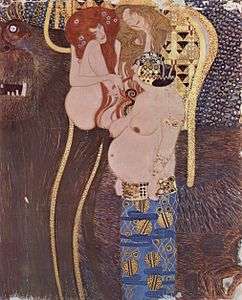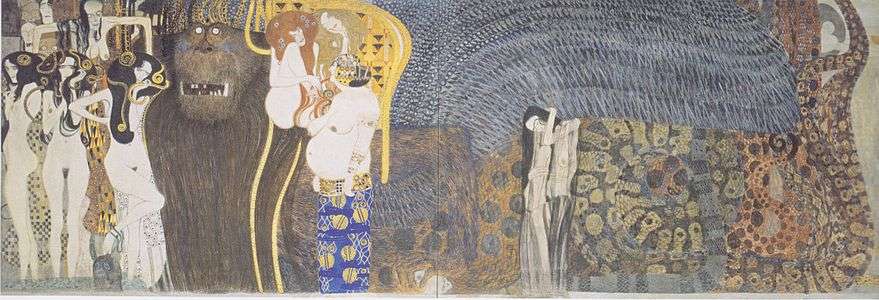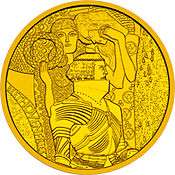Beethoven Frieze
The Beethoven Frieze is a painting by Gustav Klimt on display in the Secession Building, Vienna, Austria.
_-_5987_-_%C3%96sterreichische_Galerie_Belvedere.jpg) | |
| Artist | Gustav Klimt |
|---|---|
| Year | 1901 |
| Location | Secession Building, Vienna, Austria |

Description
In 1901, Klimt painted the Beethoven Frieze for the 14th Vienna Secessionist exhibition in celebration of the composer, and featured a monumental polychrome sculpture by Max Klinger. Meant for the exhibition only, the frieze was painted directly on the walls with light materials. After the exhibition the painting was preserved, although it did not go on display again until 1986.[1] The Beethoven Frieze is on permanent display in the Vienna Secession Building in a specially built, climate-controlled basement room.[2]
The frieze is large, standing at 7 feet high with a width of 112 feet. The entire work weighs four tons.[3]
 Left wall: "the yearning for happiness; the sufferings of weak mankind; ..."
Left wall: "the yearning for happiness; the sufferings of weak mankind; ..." "... their petition to the well-armed strong one, to take up the struggle for happiness, impelled by motives of compassion and ambition.
"... their petition to the well-armed strong one, to take up the struggle for happiness, impelled by motives of compassion and ambition. Middle wall: the hostile forces; Typhoeus the giant, against whom even gods fought in vain; his daughters, the three Gorgons, who symbolise lust and lechery, intemperance and gnawing care. The longings and wishes of mankind fly over their heads."
Middle wall: the hostile forces; Typhoeus the giant, against whom even gods fought in vain; his daughters, the three Gorgons, who symbolise lust and lechery, intemperance and gnawing care. The longings and wishes of mankind fly over their heads." Right wall: "the yearning for happiness is assuaged in poetry. The arts lead us to the ideal realm in which we all can find pure joy, pure happiness, pure love. ..."
Right wall: "the yearning for happiness is assuaged in poetry. The arts lead us to the ideal realm in which we all can find pure joy, pure happiness, pure love. ..." "... Choir of angels from Paradise. 'Joy, lovely spark of heaven's fire, this embrace for all the world."[4]
"... Choir of angels from Paradise. 'Joy, lovely spark of heaven's fire, this embrace for all the world."[4]
Depiction on coin

Because of the frieze's fame and popularity, it was made the main motif of a collectors' coin: the Austrian 100 euro Secession Coin, minted on November 10, 2004. The reverse side features a small portion of the frieze. The extract from the painting features three figures: a knight in armor representing "Armored Strength", one woman in the background symbolizing "Ambition" holding up a wreath of victory and a second woman representing "Sympathy" with lowered head and clasped hands.
See also
Notes
- "Beethoven Frieze". klimt.com. Retrieved January 22, 2015.
- "The Beethoven Frieze". Secession.at. Vienna Secession. Archived from the original on December 24, 2014. Retrieved January 22, 2015.
- Cohen, Patricia (October 15, 2013). "Heirs Press Austria to Return Looted Klimt Frieze". The New York Times. Retrieved January 22, 2015.
- "History of Art:Gustav Klimt". www.all-art.org. Retrieved 13 January 2020.
External links
| Wikimedia Commons has media related to Beethovenfries. |
- Beethoven Frieze in the online catalog of the Vienna Secession (in German)
- "Portion of Beethoven Frieze".
- Beethoven Frieze, video discussion about the painting from Smarthistory at Khan Academy